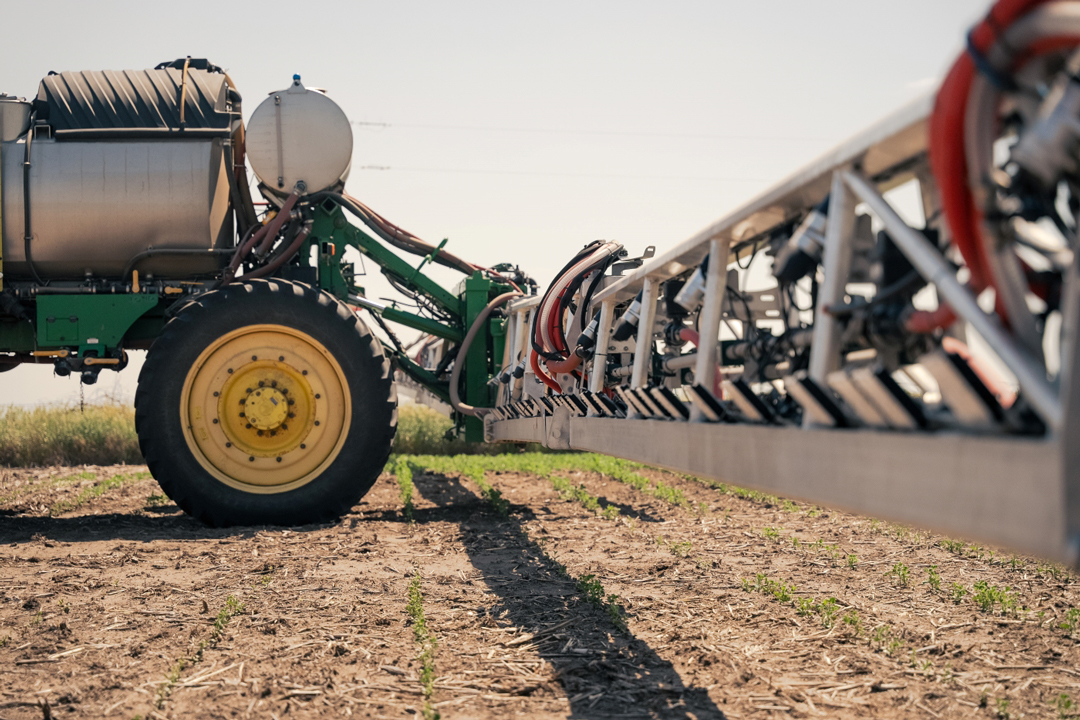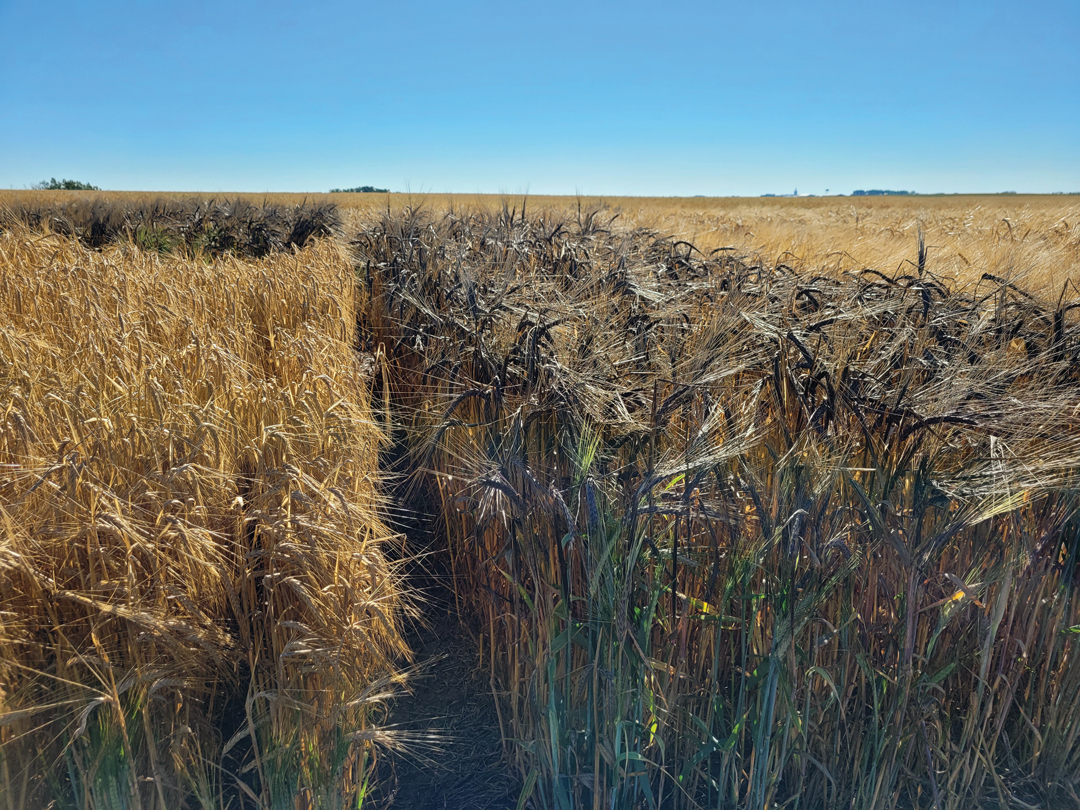LESS IS MORE
BY IAN DOIG • PHOTOS COURTESY OF GREENEYE TECHNOLOGY
The co-owner and public face of Agrimetrix Research and Training of Saskatoon, SK, Tom Wolf is a sprayer specialist. He has spent his career studying sprayer operation and best practices and communicating his findings to the agriculture industry.
In August 2025, GrainsWest spoke with Wolf about the use of optical spot sprayer technology in Western Canada. As a variety of products enter the marketplace and advancements in this technology roll out, he predicts big things are yet to come.
GrainsWest: Around the world, how prevalent are optical spot sprayers becoming?
Tom Wolf: Not as prevalent as we might think. They’re certainly being talked about, studied and trialled. They’re only very prevalent in Australia.
GW: Why are Australian farmers early adopters?
TW: Australia has a unique case where they do most cropping in their winters, which are cooler and moister than their summers. They have a chem fallow in their summers, when they still get some rainfall, so they do have weed emergence and need to do something about that. And of course, in the absence of tillage, they’ve turned to what they call summer sprays, which we would know as chem fallow. And these situations lend themselves incredibly well to spot spraying, because they might have to cover the same piece of land, three to five times per summer. Each time, if they can spot spray, they can save a lot of pesticide or herbicide. It’s also opened opportunities to use more expensive tank mixes for some of their difficult-to-control weeds, so that now becomes an affordable tank mix.
GW: What sort of potential value do optical sprayers present to Prairie farmers?
TW: Here, it’s a less clear-cut situation. It’s a little bit more difficult. For example, we’ve all but abandoned what we call summer fallow—chem fallow—and so we don’t have a lot of those acres. So, the opportunities for using a green-on-brown spot sprayer are limited to just before seeding. So, your pre-seed burn off and perhaps later in the season, maybe post-harvest, or even pre harvest weed control that might assist in harvesting ease.
The problem with all those situations is that before seeding, our weeds tend to be quite small. It makes it more challenging for spot sprayers to find the weeds and spray them accurately. And we don’t have a wide window. We only really have a few weeks between when we can get on the land and when we’re seeding it. There isn’t much opportunity for the weeds to grow any larger and make the detection easier. Problem two is, if we were going to go after harvest, that’s also a relatively small part of the market. It certainly is becoming more important, but not everybody is spraying all their fields after harvest. We are, we don’t have slam-dunk opportunities for spot spray, at least in the green-on-brown world.
GW: Is green-on-green technology used for the pre-harvest application?
TW: No, that could also be green-on-brown. Pre-harvest, at the time when you would be spraying these, would be when the cereal or pulse crop, let’s say, has essentially senesced and is not green anymore, and therefore would not trigger the spray. But you might have green spots in that crop, so you might want to desiccate to those low spots that might still be green. Or else you might hit green weeds such as kochia in pulse crops. It’s a nuisance for harvesting, and it’s important to maybe have that material dried down. Those would be green spots you would spot spray out.
GW: How are green-on-brown and green-on-green systems intended to be employed?
TW: It’s hard to say what the potential market of it is. Anywhere in Canada where we do a pre-seed burn off is a green-on-brown opportunity. The only question then is, can you see the weeds when they’re that small? And can you be assured you’ve got all the weeds that are present? There are questions about the trust farmers have in the capability of these systems. That will only grow with time and experience.
The green-on-green opportunity is, of course, gigantic. But it’s also limited. If we could spray just the weeds in any given crop field, that would be amazing. The challenge is there are certain difficulties with selectivity. If you have a cereal crop and you have grassy weeds, asking AI or any other detection mechanism to pick those out and spray just the grassy weeds would be very difficult. So, right now, we are limited. For example, we can detect a broadleaf weed in a cereal crop, that’s being done already. We can detect a grassy weed in a broadleaf crop, that’s being done already. But it’s hard to detect a broadleaf weed in a broadleaf crop and the grassy weed in a grassy crop.
The only place where that has so far been successful is in row crops. The camera is able to identify the crop [rows] and, in between, we have 30 inches of blank ground. Anything that grows in there is fair game. It’s not in the crop row, therefore it is not a crop, therefore it can be sprayed.
We see the likes of John Deere, Agrifac, Bilberry and Greeneye Technology exploiting spraying between the rows for the green-on-green system. That’s working. When will that come to small, seeded grains, oil seeds and pulse crops? It’s not here yet. We can do it, but with the limitations I mentioned.

GW: How eager are western Canadian farmers to try out these units?
TW: Quite eager, I think. With any new technology, there’s tremendous promise, hype and excitement, but you have to take a small leap of faith when you get into it. You are not necessarily assured it’s going to meet your expectations right now. There are always people who believe in the principle, want to be at the cutting edge of the technology development, to learn with the technology and maybe upgrade as it becomes better.
GW: What additional factors limit adoption?
TW: Some companies are charging a fee for use of the technology. There are different models in the market for how that user fee is being implemented. There’s still some fine tuning there.
We talk about the so-called inkjet model—when you buy a very cheap inkjet printer, but the print cartridges are very expensive. That’s kind of the model that somebody like John Deere is using. They’re selling their systems relatively inexpensively, but in the green-on-green space, they’re asking for user fees. And then there are other companies that say, ‘We’re going to charge you a larger hardware fee, make our money selling hardware but then it’s free from that point.’
GW: What is the user’s best bet to maximize performance?
TW: You have to look at your farming system to see whether it has a place. It’s really a resistance management technology for many people. Most farmers are aware that, for example, herbicide resistance is a growing problem. It’s going to become more difficult to control weeds with a relatively simple tank mix—maybe just a couple of modes of action. So, they will have to migrate to a more expensive tank mix to cover off the various resistance incidents, for example, in kochia. Maybe a spot spray is the best way to make that affordable.
GW: What may come next in the development of optical spot sprayer technology?
TW: There will be new entries into the market. All the companies are continually evolving capabilities. Watch what’s happening on Chat GPT from a regular consumer perspective. We know that in the last two or three years, there have been tremendous gains made in how well AI systems work. Similar gains are being made in the optical recognition field.
There’s tremendous opportunity for improvement in detection capability that might make it suitable in small grains and oil seeds and pulse crops like we have here in Western Canada. I’m very optimistic.
Your question does raise another point. We don’t have to go from broadcast spraying to spot spraying individual leaves in one fell swoop. We can migrate into this field incrementally.
For example, we might have to identify patches of weeds. And we can do that, not an individual nozzle basis, but maybe on a sectional basis, or even a whole boom basis. And we might be able to become more familiar with this whole concept by gradually introducing those kinds of technologies, it’s easier to scout for that. Companies like Geco Engineering that have used satellite imagery to identify patchiness of weeds and fields, and there’s Corptimistic Technology that identifies the weediness of a particular SWAT zone.
We’re moving towards site specific, but we don’t have to do it in one step. We might want to do it in a few steps that are easier and then get to finer resolution over time.
GW: What advice do you have for farmers interested in this technology?
TW: Keep your eye on this very active space. Tremendous resources are being spent to make it better, and it will get better. It will become interesting at some point for most farmers, I believe. It will change how we view and implement spraying spraying.
It’s sad to say, but the era of easy herbicidal weed control is over. We are not developing new herbicides, so we must use the ones we have left as effectively as possible to extend their utility into the future. At some point, even that utility will be diminished. And then, if we don’t have replacement herbicides, we will need to use other tools, like cultural tools, crop rotation, crop competitiveness, intercropping and cover cropping to manage weeds. Spot sprayers have an opportunity to prepare us for that time and buy us time to get ready for the next stage, whatever that’ll be.






Comments